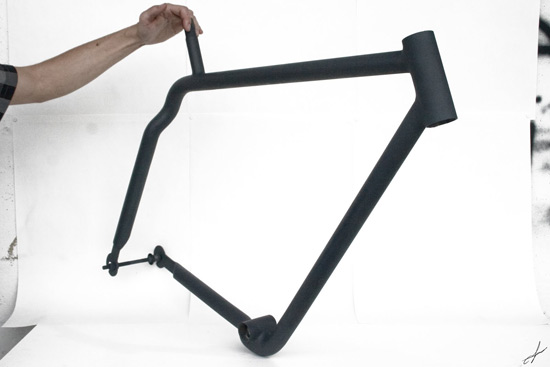Design: the difference between chairs, bikes, and jetpacks
I’ve got this problem with “design” bikes. You know, the kind of bike you see in Wired or on some design blog. Sometimes I fear that I’m destined to be the crotchety naysayer, but it infuriates me that the general public cannot differentiate between a design exercise and practical product. A bicycle is not like some avant garde Danish chair: a chair can be uncomfortable but people still seem to like it but a bike is a vehicle for which design has consequences.

This “Victor Bike” is the current target of my ire. Two different design blogs vomited their irrational accolades on the bike design, followed by a wave of blissed out design posers. The gist of the design is that instead of having a traditional diamond frame, the Victor Bike has large diameter tubing manipulated in such a way to suggest a single continuous line that winds from the left rear axle to the bottom bracket up around the steerer, then aft under the saddle before finally diving down to the right rear axle.

I was stunned when I read one of the blogs state: “The various bends allow it to use less metal, and less welds. Ergo, the bike frame is green, in a way.”
I can’t believe someone who has any claim to knowledge of “design” could say this.
By looking at this design, I can show you how at just about every point on this frame where stresses are concentrated, the Victor’s designer chose a configuration that is weaker than a diamond frame. If you tried to use tubing thin enough in the Victor Bike to make it as light as a diamond frame, then the fanciful frame would distort or fail immediately. I can see how this bike was created purely for the aesthetic of a single line, and I understand why the designer chose to have the chainstay on the left side: the large diameter tube would have fouled the chainring. However, the Victor fails to offer the necessary support structure to counter the chain forces on the right side. Vertical loads created by the rider are an even more obvious problem. Since the Victor’s structure at each turn takes the less direct approach to countering the loads, the tubing walls would have to be massive to have any hope of maintaining dynamic alignment, and probably for the static load of the rider as well.
Some of the Victor’s “lavish” details include integrated front and rear reflectors as well as “gorgeously curved rear fender”. First: integrated reflectors? Really? Really? Does it really take so little effort to impress bloggers? Some molding putty and a pair of 25cent reflectors gets you a big write-up? And then, I think it’s time we all get over the idea that we could somehow put a fender on cow dung and call it practical design.
The blog further claims that the diamond frame is a “relic of the mid-20th century manufacturing capabilities. ” First, this is historically inaccurate as the diamond frame was well established by the late 19th century. Beyond that, the idea that manufacturing capabilities have changed significantly can at best be described as a matter of opinion, as the blogs claim that the Victor is made of steel. I’d bet money that the steel used is good ol’ ASTM 4130, aka “chromium-molybdenum steel” or”cromoly”, and it also predates the mid-20th century. I have no conception of what that blogger thinks is so different about the construction techniques employed for the Victor. Regardless, the laws of physics have not nor will ever change. Even if Tinkerbell waved her magic wand and created ecologically-friendly cromoly tubing from gingerbread and dreams, the Victor design fails miserably in a head-to-head structural comparison with a diamond frame.
Designers are taking the piss saying the diamond frame is a relic. Whenever you’re using metal tubes, the diamond frame’s structure deftly deals with the static and dynamic loads with an elegance that apparently cannot be appreciated with the eye. While there are numerous alternative configurations out there (eg step-thru frames, etc) that diverge from the basic diamond configuration, the fact is that its strength-to-weight ratio is boss.
If I’m looking at the Victor as a design exercise, I can appreciate the wit and visual elegance of the form, but it is laughable to read these “design” geezers laud it as the wave of the future. It’s the same lack of objective reasoning that fifty years ago promised jetpacks to the citizens of tomorrow.
